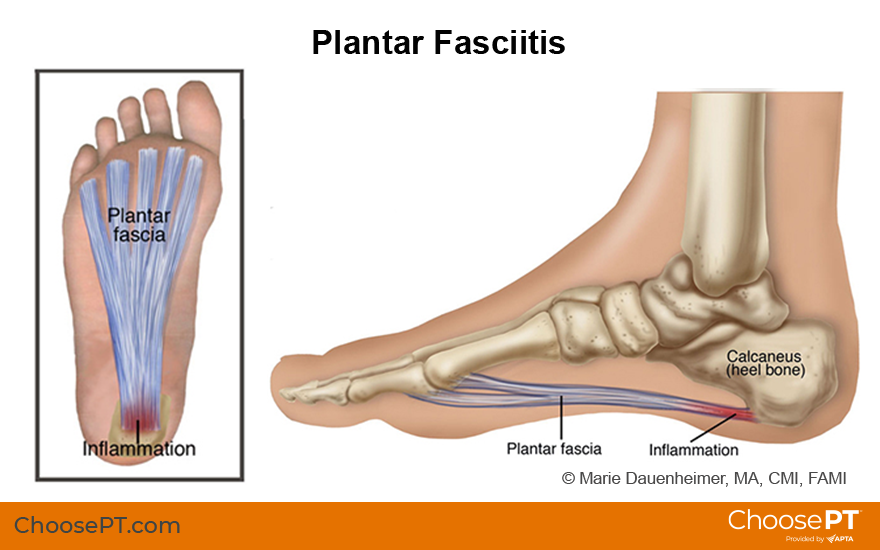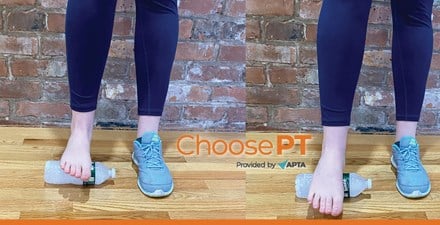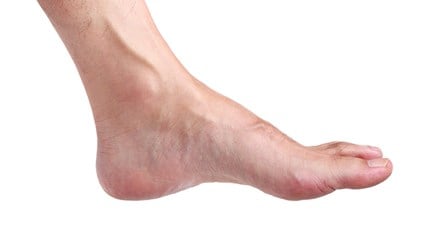Physical Therapy Guide to Plantar Fasciitis
Plantar fasciitis is a condition causing foot pain. The plantar fascia is a thick band of tissue that supports the arch of your foot. It connects the heel to the ball of the foot. This band can become inflamed or can tear, causing pain. Pain can be felt in the heel, along the arch, or at the ball of the foot. Plantar fasciitis is a common foot condition. It occurs in as many as 2 million Americans per year and 10% of the population over their lifetimes. Plantar fasciitis affects people of all ages, both athletes and nonathletes. Men and women have an equal chance of developing the condition. Physical therapists help people experiencing plantar fasciitis reduce their pain and restore their walking ability.
Physical therapists are movement experts. They improve quality of life through hands-on care, patient education, and prescribed movement. You can contact a physical therapist directly for an evaluation. To find a physical therapist in your area, visit Find a PT.
What Is Plantar Fasciitis?
Plantar fasciitis is a foot condition that develops when repeated activities put a strain on the plantar fascia, a thick band of tissue that supports the arch of the foot. People diagnosed with plantar fasciitis also may have heel spurs, a bony growth that forms on the heel bone.
Plantar fasciitis occurs most frequently in people in their 40s, but can occur in all age groups.
The condition can develop in athletes who run or jump a great deal, and in people who have jobs that require them to be on their feet for most of the day, such as police officers, cashiers, or restaurant workers.

Signs and Symptoms
Symptoms of plantar fasciitis often appear with a sudden increase in activity. You might feel a stabbing pain on the underside of your heel, and a sensation of tightness and/or tenderness along your arch.
People with plantar fasciitis may experience pain:
- In the morning, when stepping out of bed and taking the first steps of the day.
- When standing for a long time.
- When standing up after sitting for a long time.
- After intense activity such as running or jumping.
- When climbing stairs.
- When walking barefoot or in shoes with poor arch support.
Your pain can fluctuate during the day, with pain improving as your body warms up and worsening later in the day after activity. As the condition gets worse, you may begin to limp.
How Is It Diagnosed?
The physical therapist's diagnosis is based on your health and activity history, and on a clinical evaluation. Your physical therapist also will take a medical history to make sure that you do not have other conditions that may be causing your pain. Sharing information about your work and recreation, and reporting any lifestyle changes will help your physical therapist diagnose your condition and tailor a treatment program for your specific needs.
To diagnose plantar fasciitis, your physical therapist may conduct the following physical tests to see if symptoms occur:
- Observing, measuring, and assessing your foot, ankle, and arch position in weight-bearing and nonweight-bearing positions. Massaging and pressing (palpation) on the heel area, arch of the foot, toward the toes.
- Gently stretching the ankle to bend the top of the foot toward the leg (dorsiflexion) to assess the flexibility of the muscles in your lower leg.
- Gently pressing the toes toward the ankle.
How Can a Physical Therapist Help?
Physical therapists are trained to evaluate and treat plantar fasciitis.
When you are diagnosed, your physical therapist will work with you to develop a program to decrease your symptoms. Your treatment may include:
Assessment of your gait. Your physical therapist will observe how you walk (your gait) and how this may impact your symptoms.
Stretching exercises. Your physical therapist will design a program to improve the flexibility of your ankle and the plantar fascia.
Strengthening exercises. Your physical therapist will design an exercise program to improve the strength and endurance of the muscles that support your foot.
Application of ice. Your physical therapist will instruct you on how often and how long to use ice to decrease pain and inflammation.
Taping of the foot. Your physical therapist may tape your foot and instruct you on how to use taping for short-term pain relief.
Orthotics (shoe inserts) and supportive footwear to minimize abnormal foot motion, or to help support your arch, reducing stress to the plantar fascia.
A night splint to help you maintain correct ankle and toe positions while sleeping.
Gait training to help lessen symptoms and improve your walking ability.
Research shows that most cases of plantar fasciitis improve over time with these conservative treatments, and surgery is rarely needed.
A treatment program may begin with these exercises that you can try at home.
Can This Injury or Condition Be Prevented?
Factors that contribute to the development of plantar fasciitis include:
- Age (over 40 years).
- A job, sport, or hobby that involves prolonged standing or other weight-bearing activity.
- Rapid increases in length or levels of activity, such as beginning a new running program or changing to a job that requires a lot of standing or walking.
- Decreased calf muscle flexibility.
- Increased body weight (Body Mass Index greater than 30).
- Flat feet.
- Wearing shoes such as high heels, or those with inadequate arch support.
Guidelines for the prevention or management of plantar fasciitis include:
- Choosing shoes with proper arch support and heel height.
- Replacing your shoes regularly, before they wear out.
- Using a thick mat if you must stand in one place for much of the day.
- Adjusting your exercise program to include a warmup and a gradual buildup, to avoid straining the plantar fascia.
- Stretching your calves and feet before and after running or walking.
- Maintaining a healthy body weight.
Your physical therapist will design a personalized treatment program to help heal your plantar fasciitis and prevent future injury.
What Kind of Physical Therapist Do I Need?
All physical therapists are prepared through education and experience to treat plantar fasciitis. However, you may want to consider:
- A physical therapist who is experienced in treating people with orthopedic and sports injuries, particularly those with experience working with the ankle and foot.
- A physical therapist who is a board-certified clinical specialist or who completed a residency or fellowship in orthopedic or sports physical therapy, meaning that this physical therapist has advanced knowledge, experience, and skills that may apply to your condition.
You can find physical therapists who have these and other credentials by using Find a PT, the online tool built by the American Physical Therapy Association to help you search for physical therapists with specific clinical expertise in your geographic area.
General tips when you're looking for a physical therapist (or any other health care provider):
- Get recommendations from family, friends, or other health care providers.
- Search the internet to find reviews on local clinics and provider backgrounds.
- Contact a physical therapy clinic and ask about the physical therapists' experience in helping people who have heel pain.
- Be prepared to describe your symptoms in as much detail as possible, including when symptoms started, what makes your symptoms worse, and what makes them better.
The American Physical Therapy Association believes that consumers should have access to information that could help them make health care decisions and also prepare them for a visit with their health care provider.
The following articles provide some of the best scientific evidence related to physical therapy treatment of plantar fasciitis. The articles report recent research and give an overview of the standards of practice both in the United States and internationally. The article titles are linked either to a PubMed* abstract of the article or to free access of the full article, so that you can read it or print out a copy to bring with you to your health care provider.
Koc TA, Bise CG, Neville C, et al. Clinical Practice Guidelines – Heel Pain – Plantar Fasciitis: Revision 2023. J Orthop Sports Phys Ther 2023;53(12):CPG1-CPG39. Article Summary in PubMed.
Grim C, Kramer R, Engelhardt M, et al. Effectiveness of manual therapy, customised foot orthoses and combined therapy in the management of plantar fasciitis—a RCT. Sports (Basel). 2019;7(6):128. Article Summary in PubMed.
McClinton SM, Heiderscheit BC, McPoil TG, Flynn TW. Effectiveness of physical therapy treatment in addition to usual podiatry management of plantar heel pain: a randomized clinical trial. BMC Musculoskelet Disord, 2019;20(1):630. Article summary in PubMed.Landorf KB. Plantar heel pain and plantar fasciitis. BMJ Clin Evid, 2015;2015:1111. Article Summary in PubMed.
Kirkpatrick J, Yassaie O, Mirjalili SA. The plantar calcaneal spur: a review of anatomy, histology, etiology and key associations. J Anat. 2017;230(6):743–751. Article Summary in PubMed.
Kaiser PB, Keyser C. Crawford AM, et al. A prospective randomized control trial comparing physical therapy with independent home stretching for plantar fasciitis. J Am Acad Orthop Surg. 2022;30:682-689. Article Summary in PubMed.
Hamstra-Wright k, Huxel Bliven K, Bay R et al. Risk factors for plantar fasciitis in physically active individuals: a systematic review and meta-analysis. Sports Health. 2021;13:296-303. Article Summary in PubMed.
Rhim H, Kwon J, Park J, et al. A systematic review of systematic reviews on the epidemiology, evaluation and treatment of plantar fasciitis. Life (Basel). 2021;11:1287. Article Summary in PubMed.
*PubMed is a free online resource developed by the National Center for Biotechnology Information. PubMed contains millions of citations to biomedical literature, including citations in the National Library of Medicine's MEDLINE database.
Expert Review:
Jul 15, 2024
Revised:
Jul 16, 2024
Content Type: Guide
Plantar Fasciitis
PT, PhD, board-certified specialist in orthopaedic physical therapy
James E. Zachazewski
PT, DPT, board-certified clinical specialist in sports physical therapy, on behalf of the American Academy of Sports Physical Therapy
You Might Also Like...
Health Tips
Six Exercises for Plantar Fasciitis and Heel PainMar 26, 2024
Research shows that both strengthening and stretching exercise programs can greatly reduce pain and improve walking in people with plantar fasciitis. These
Health Tips
Three Myths About Running, Plus Tips for TrainingNov 3, 2020
“Train well, race well,” is the healthy running mantra of Physical therapist Robert Gillanders. Consider these myths and tips for healthy running from
Podcast
Foot Health: Avoiding Pain and InjuryJul 9, 2019
A chain is only as strong as its weakest link. Chris Neville, PT, PhD, would like you to consider how that saying applies to your feet and ankles.


